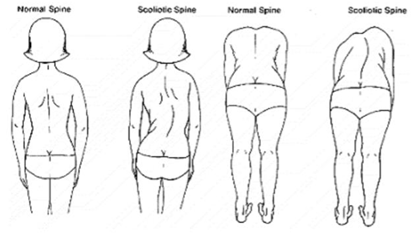
Scoliosis Fact Sheet
Information on scoliosis and methods for early detection.
What is scoliosis?
Scoliosis is an abnormal curvature of the spine. A spine affected by
scoliosis has a sideways curve, making it appear more like an "S" or a "C" than a straight line. Untreated scoliosis can lead to limited motion, back pain, deformity, and in extreme cases, impaired function of the heart and lungs. Early detection and treatment may prevent scoliosis from progressing.
When should my child be screened for scoliosis?
Scoliosis most commonly occurs during the growing years, between age 10 and the time an adolescent is fully grown. Screenings should begin in early adolescence. Pediatricians should check for early signs during a routine physical exam.
What causes scoliosis?
The cause of scoliosis is unknown. Scoliosis is more common in females than males.
How is scoliosis treated?
In many cases, the curve is mild and does not require treatment. In some cases, treatment may involve bracing. Severe curves may require spinal surgery. The need for treatment is best determined by a trained medical professional.
What are the signs of scoliosis?
- One shoulder may be higher than the other.

- One shoulder blade may be higher or more prominent than the other.
- One hip appears higher or more prominent than the other.
- Unevenness of the waist.
- The spine curves sideways.
- The head is not centered over the pelvis.
If you have any concern that your child may have scoliosis, make sure that your child is screened by a health care provider. For additional resources and information, please contact the school Public Health Nurse (PHN).
For more information visit the Scoliosis Research Society website.
Printable PDF Translations
Scoliosis Fact Sheet
If you have any concern that your child may have scoliosis, make sure that your child is screened by a health care provider. The school Public Health Nurse (PHN) may provide screening for individual students at the request of the parent or guardian.